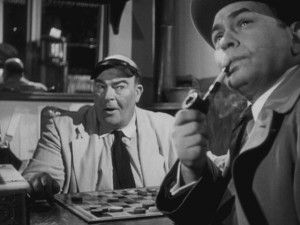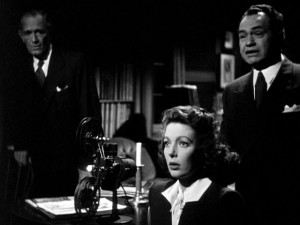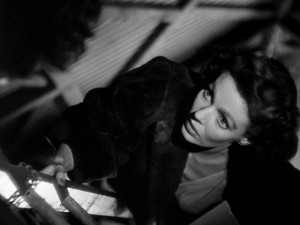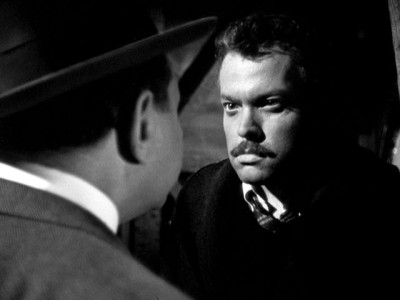
With the typical perversity of humankind, it follows that the only movie Orson Welles directed that turned a profit on its original release — The Stranger (1946) — is also his least celebrated. A film historian friend of mine recently grumbled that a “well-behaved Welles” wasn’t really Welles. I understand his point, but it’s my take that it was less a matter of Welles being well-behaved on The Stranger than it was the fact that the material was peculiarly suited to his cinematic world of obsessives. Here, after all, is a film that gave him two obsessives for the price of one — one a rank villain and the other a hero of dubious morality in his own right. It also afforded Welles the chance to bring his expressionist style to an otherwise Norman Rockwell-like New England, which allowed him to lay bare the corruption beneath the facade of a sunlit vision of small town America. In its own way, The Stranger is similar to Alfred Hitchock’s Shadow of a Doubt (1943) on one side and David Lynch’s Blue Velvet (1986) on the other. All this (and a grotesquely Baroque climax that must have warmed Welles’ heart) is simply unforgettable, and makes for a movie that I find hard not to love.

The Stranger was nothing if not timely when it was first released, since it pits a Nazi hunter known as Mr. Wilson (Edward G. Robinson) against a Nazi, Franz Kindler (Welles), who has made his escape to America and is living there as respectable college professor Charles Rankin. The professor is so respected,in fact, that he’s about to marry Mary Longstreet (Loretta Young), the daughter of a Supreme Court justice (Philip Merrivale). At the start of the film, Wilson doesn’t know this, but he does know that if he allows convicted war criminal Konrad Meinike (Konstantin Shayne) to escape, the man will lead him to Kindler. Wilson’s obsession in this regard is little short of frightening.“This obscenity must be destroyed! Do you hear me? Destroyed!” he yells at those responsible from Meineke with such ferocity that he breaks his pipe in the process. (Welles gets the good out of the broken pipe stem, using its conspicuously taped together stem for identifying Wilson without showing him for part of the film.)

His plan works and he follows Meineke to the small town where Kindler is hiding, but Meineke knocks Wilson unconscious with some equipment (wryly labelled to be used at your own risk) in the local college gymnasium. And before Wilson regains consciousness, Kindler murders Meineke. It doesn’t take much for Wilson to figure out that Kindler is Rankin, but proving it is another matter. And convincing Kindler’s new wife of her husband’s guilt is something else again. Even showing her footage of her husband’s concentration camp handiwork — a scene that prefigures a similar one in Carol Reed’s The Third Man (1949) — doesn’t quite overcome her denial. It’s here that the darkest side of Wilson and his own obsession becomes uncomfortably clear — when he reveals to the woman’s father that allowing Kindler to murder Mary would provide excellent proof!

The whole film is brilliantly shot and played — Robinson, Welles and Young are in fine form — with a tense climax that, as I said, is never forgotten by those who see it. This may not be Welles at his absolute best as a filmmaker, but neither is it a film to be dismissed — and it’s a lot more Wellesian than is casually assumed.




Before you comment
The comments section is here to provide a platform for civil dialogue on the issues we face together as a local community. Xpress is committed to offering this platform for all voices, but when the tone of the discussion gets nasty or strays off topic, we believe many people choose not to participate. Xpress editors are determined to moderate comments to ensure a constructive interchange is maintained. All comments judged not to be in keeping with the spirit of civil discourse will be removed and repeat violators will be banned. See here for our terms of service. Thank you for being part of this effort to promote respectful discussion.